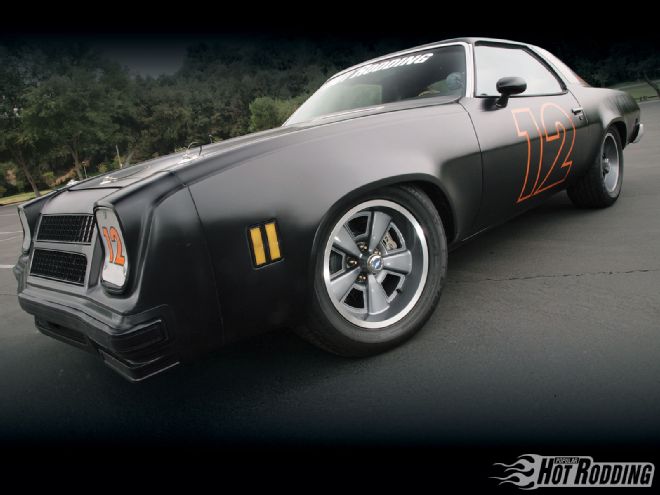
In every gearhead's mechanical life, there are certain "aha" milestones. A few of mine: The revelation that a numerically higher set of gears will accelerate the car faster without any engine work. Then there was the discovery of throttle oversteer when I gassed it hard while making a right-hand turn in a busy intersection. Or how about the first time I put a blower on a V-8, then christened it on the street with a felony burnout? Some of my "aha" moments are fond memories, others are embarrassments, and still others are downright dangerous.
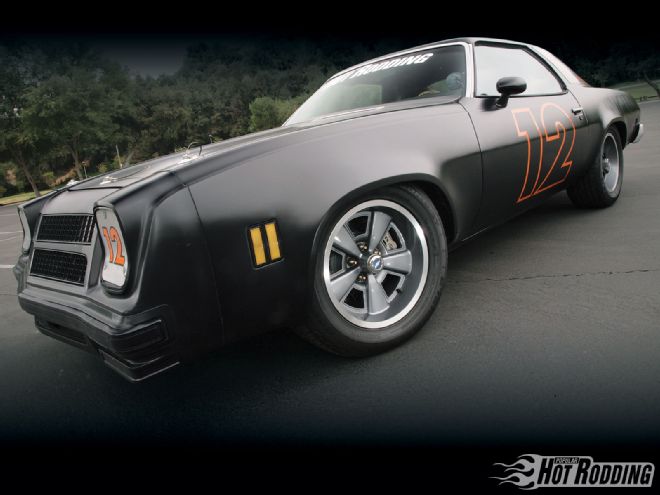
There are three particular "aha" moments in my hot rodding life that were both embarrassing and dangerous at the same time. All of them have to do with inadequate brakes. In all three instances, I could've gotten hurt or wrecked my car, but I was lucky enough to come out unscathed. (Actually, there were a lot more incidences, but these are the scariest.) See if any of these rings a bell.
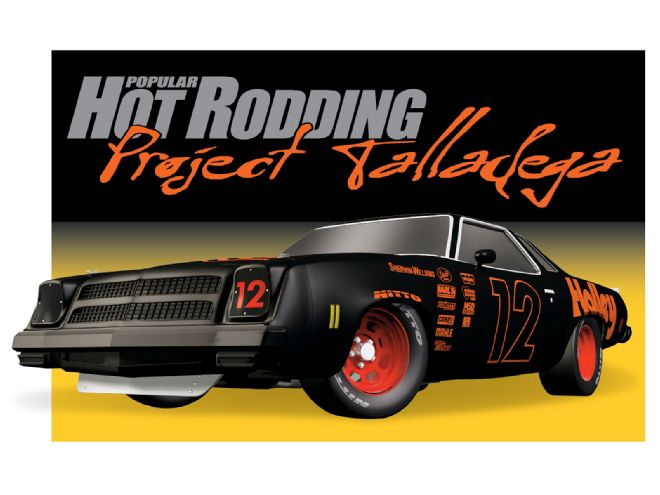
Has This Happened To You?
The year was 1982, and the car was a four-door '72 Malibu-with manual drum brakes all around. I'd had the car for a few months, and found the brakes adequate, but not great. They worked OK, so I never gave them a second thought. Then driving to work one day in a gully washer downpour, I rolled through a deep puddle, then tried to stop for a red light. No freakin' brakes! It was like someone smeared axle grease on all the brake shoes. I ran the red light, and thank goodness no one was in the intersection. I burned one of my nine lives that day.
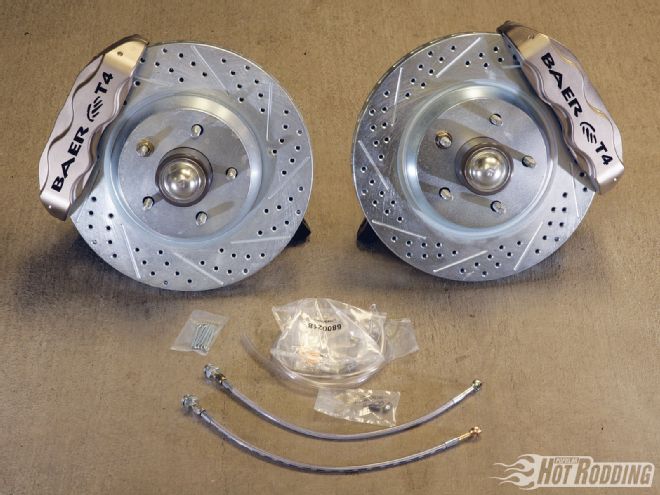 Baer's Track-4 is made for a variety of muscle cars including Chrysler B- and E-Body, Ford Mustang ('65-04), GM A-body ('64-77), GM fullsize ('58-76), Corvette ('84-96), GM G-body ('78-88), and GM X-body ('64-74). The price range is pretty wide, starting at $895 (for cars upgrading from an existing Baer PBR Track kit), then to $1,195 (uses OEM spindles and hubs), and from there going to $1,395 (includes new spindles and Baer aluminum hubs). You can also get the Track-4 with a variety of spindle modifications for an additional charge.
Baer's Track-4 is made for a variety of muscle cars including Chrysler B- and E-Body, Ford Mustang ('65-04), GM A-body ('64-77), GM fullsize ('58-76), Corvette ('84-96), GM G-body ('78-88), and GM X-body ('64-74). The price range is pretty wide, starting at $895 (for cars upgrading from an existing Baer PBR Track kit), then to $1,195 (uses OEM spindles and hubs), and from there going to $1,395 (includes new spindles and Baer aluminum hubs). You can also get the Track-4 with a variety of spindle modifications for an additional charge.
A few years later, I bought a brand-new '87 Mustang 5.0L LX. It was awesome fast for its day, and I had a weakness for being goaded into high-speed hooligans on the highway. When a Nova pulled up beside me on the last light out of town, we hit it. I got out on the guy, but he was still dogging me. This went on for a few miles, and by the time my exit came into sight, the speedo was buried. I started braking, and by the time I got it down to 70, the brakes were spent. The car shuddered violently, the rotors were warped, the fluid was boiled, and I was along for the ride. Being a young idiot, I still tried to make the exit, and slid the car sideways across three lanes of traffic. I dodged a bullet again. Heart racing, I pulled to the side of the road, got out, and looked at the stupid 11-inch brakes. They were ticking, and glowing cherry red.
Fast-forward to 1999. I was running my '93 Firebird at Watkins Glen in a late-day session. My lap times were going down with every circuit, and the stroked 396 LT1 underhood was pulling uphill through the esses like a freight train. I was feeling like Neil Bonnett as I hit 140 at the top of the backstretch. Somewhere between the 400- and 300-foot brake markers, I stabbed the brake pedal, and it went straight to the floor. I plowed through the "bus stop" cones going about 120, and brought out the yellow flag to end my session.
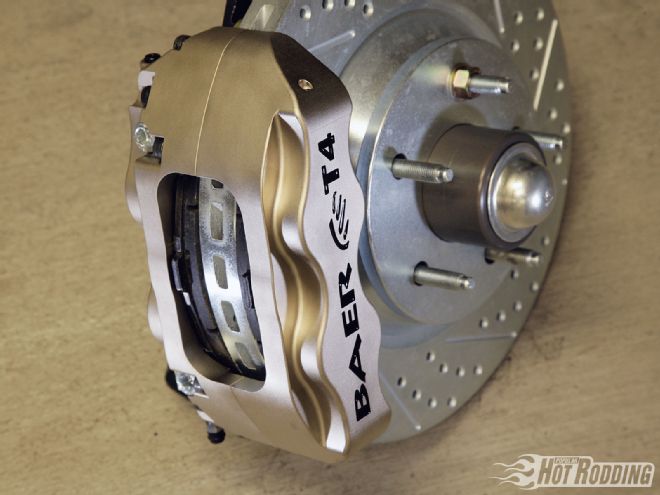 The meat of the Track-4 kit is Baer's proprietary T4 caliper, a fully machined extruded alloy billet caliper with four pistons and an internal fluid passage for balanced braking force. The zinc-washed slotted and cross-drilled rotor measures 13 inches by 1.10 inches thick, and is directionally vaned for cooling. They key to good braking is two-fold: generating maximum torque, and managing the heat for repeatability. The Track-4 does both at an affordable price.
The meat of the Track-4 kit is Baer's proprietary T4 caliper, a fully machined extruded alloy billet caliper with four pistons and an internal fluid passage for balanced braking force. The zinc-washed slotted and cross-drilled rotor measures 13 inches by 1.10 inches thick, and is directionally vaned for cooling. They key to good braking is two-fold: generating maximum torque, and managing the heat for repeatability. The Track-4 does both at an affordable price.
It took these instances, and a few more "minor" ones to convince this hardheaded editor that good brakes aren't a luxury; they're a necessity. As my examples show, the power underhood clearly dictates what you need for brakes, and it doesn't even matter if you're road racing or autocrossing, because let's get real, you're going to "hit it" just like I did. More snot underhood is clearly a shout-out for better brakes. In the case of Project Laguna, we were clearly headed for a déjà vu experience: with a 560hp solid-roller small-block underhood, 4,000 pounds of curb weight to manage, and dinky 15-inch wheels, I had set myself up unwittingly to star in the next Jackass movie. I gave Baer Brakes a call.
The Baer Difference
With help from Baer's Rick Elam, it dawned on us that our 15-inch Bassett steelies were out of the question. We needed real estate inside those rims, plain and simple. New rims and tires would be required, so we hooked up with Year One for a set of their new bitchin 17x9 Rally wheels, and Continental for some Cross Contact 275/55R17 meats. (Check out the "Wheel & Tire Fitment" sidebar for details.) With the wheels on hand, we were able to do a virtual test-fit of several Baer brake systems by using bitmap templates that we printed out. (You can download them from the Baer website.) We mounted these on stiff cardboard, cut them out, and stuck them inside the Year One wheel to see if anything fit.
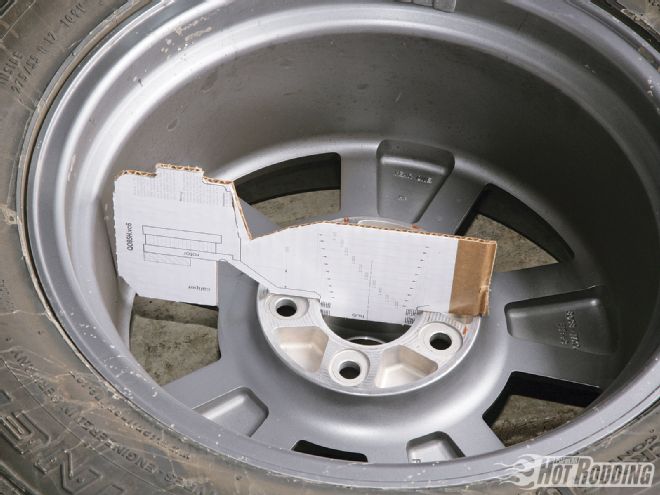 Before ordering any brake system, Baer suggests you check the fitment first. Baer will send you a bitmap template of the system you like; print it out (check it for scale accuracy with a ruler), glue it to some stiff cardboard, and cut it out. If it clears your wheel, you're good to go! If it doesn't fit, you haven't spent a dime.
Before ordering any brake system, Baer suggests you check the fitment first. Baer will send you a bitmap template of the system you like; print it out (check it for scale accuracy with a ruler), glue it to some stiff cardboard, and cut it out. If it clears your wheel, you're good to go! If it doesn't fit, you haven't spent a dime.
When it comes to brakes, bigger is truly better. That thought in mind, we wanted to put Baer's new six-piston Pro Plus system up front, but the sheer size of the six-piston caliper was just too large. Baer says the Pro Plus will fit on some 17-inch rims, but the template didn't clear the drop center of the Year One rim. The next size down was the Track-4 kit, which uses Baer's new four-piston T4 caliper. This was what we chose, being that it was the largest we could fit. The Track-4 kit combines the T4 caliper with 13-inch one-piece rotors, performance pads, billet hubs, spindles, and brake lines. Our Baer Claw Track-4 front kit also had the optional nickel plating on the calipers (an extra $100), which brought the system to $1,645.
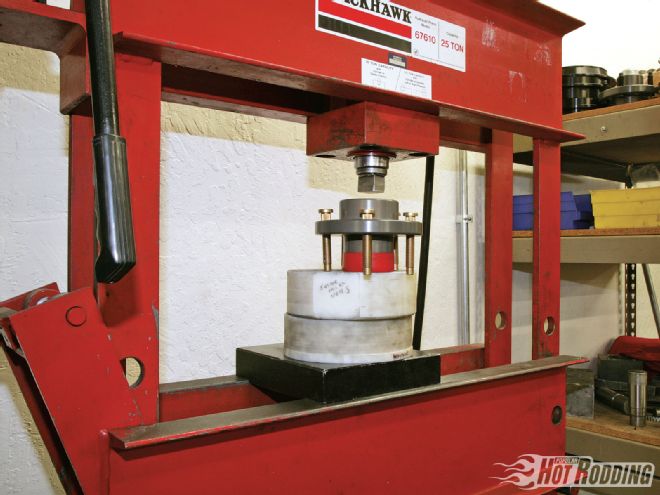 All Baer brake systems are built to order from parts in inventory. That means the degree of customization is high, yet turnaround is fast. We wanted to keep the NASCAR-look wheel studs, so Baer pressed-in large ARP studs while we waited.
All Baer brake systems are built to order from parts in inventory. That means the degree of customization is high, yet turnaround is fast. We wanted to keep the NASCAR-look wheel studs, so Baer pressed-in large ARP studs while we waited.
It warrants pointing out that although many brake manufacturers have excellent hardware, the biggest advantage we've come to appreciate with Baer is the depth of their technical support. An effective brake system goes beyond pretty parts-a manufacturer has to understand the engineering principles and know what fits on a case-by-case basis. Right off the bat, Baer suggested we change master cylinder on the Laguna. Our large 1 1/8-inch diameter bore would not be able to provide sufficient pressure for the increased piston volume, so they supplied us with a 15/16-inch bore master cylinder from Classic Performance Products (PN 6150012, $115).
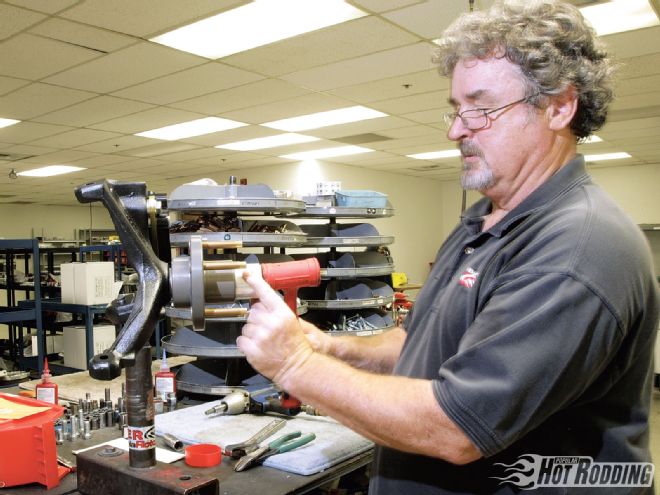 Baer's Dutch Miller assembled the Track-4 kit for our '75 Chevy Laguna using new U.S.-made spindles, billet hubs, new ARP studs, and proprietary caliper brackets. All Baer Track-4 systems that come with spindles are lubed and preassembled, making home installation a cinch.
Baer's Dutch Miller assembled the Track-4 kit for our '75 Chevy Laguna using new U.S.-made spindles, billet hubs, new ARP studs, and proprietary caliper brackets. All Baer Track-4 systems that come with spindles are lubed and preassembled, making home installation a cinch.
One of the reasons Baer has such good technical support is that they install and test their systems on a multitude of cars in-house. That task is largely the job of Baer technician, Dutch Miller. Baer's R&D installation center is colocated with Baer's manufacturing headquarters in Phoenix, an arrangement that allows Baer's engineering and manufacturing departments to work out potential real-world problems before they hit customers. Miller's unique position made him the perfect guy to install our Track-4 front system and CPP master cylinder. It's always a pleasure to work with Miller, and our Laguna's Track-4 kit was no exception. He was ready for us, and had us out the door in about a half day, including the time it took to replace the standard wheel studs with race-spec ARP studs.
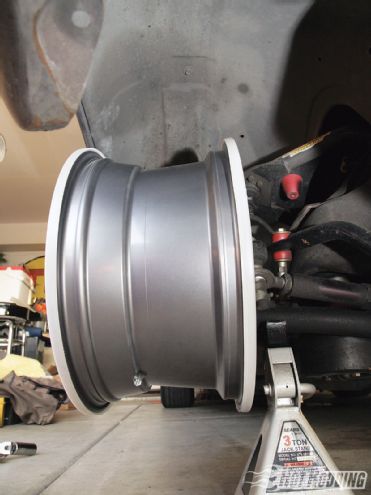 Miller drops the assembled Track-4 corner unit inside our new 17x9 Year One Rally wheel and verifies there is plenty of caliper-to-wheel clearance. We already knew from the template we were OK, but this proved it.
Miller drops the assembled Track-4 corner unit inside our new 17x9 Year One Rally wheel and verifies there is plenty of caliper-to-wheel clearance. We already knew from the template we were OK, but this proved it.
With the Baer Track-4 system installed, we got no unexpected surprises on the 400-mile drive back to Southern California. Compared to our stock single-piston D52 calipers and 12-inch rotors, the four-piston T4 calipers and 13-inch rotors felt like throwing a grappling hook from the rear bumper-all while providing an evenly modulated braking force. These binders are truly as good as the name implies; we will have no problem beating on these brakes all-day long at the track, and that's an "aha" moment we'll be proud to experience!
Wheel & Tire Fitment
The '73-77 GM A-body-particularly the Chevy Laguna-is known for its large, tank-like body, huge wheelwells, and bulging wheel arches, so the smaller performance tires that fit Chevelles, Camaros, and Novas just don't look large enough for the proportions of the car. Looking through various manufacturer tire size charts, we quickly came to the conclusion that we needed something along the lines of a performance sport truck tire size. General Tire makes a very good one-the Cross Contact UHP (ultra high performance)-in a 275/55R17 (UTQG 420 treadwear rating, AA traction, A temperature), which fits a 17x9 rim perfectly, and has a 28.9-inch diameter and an 11.2-inch section width. That's a tad taller than our old 275/60R15s, and about the same width.
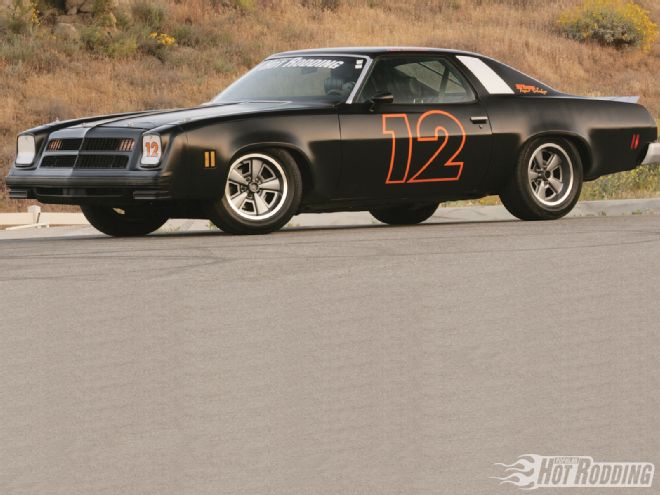
With the old wheel/tire combo (275/60R15 tires on 15x8 Bassett steel rims) and cut Global West springs, it was a snug fit, but we never experienced any rubbing. Our new Year One wheels are an inch wider with a 5-inch backspacing, compared to our 8-inch-wide steelies with a 4.5-inch backspacing. The new wheels would essentially put the outside of the rim a half-inch closer to the fender, and a half-inch closer to the inside, thus splitting the extra width evenly between outside and inside.
 All that figuring isn't as good as actual measuring. We ordered the wheels and tires, but stopped short of mounting them. We kept the plastic rim protectors on the rim and bolted the rim to the front. Using a jackstand under the ball joint, we lowered the car to put weight on the suspension. We cranked the wheel both ways, checking for clearance with the control arms, and found no issues.
All that figuring isn't as good as actual measuring. We ordered the wheels and tires, but stopped short of mounting them. We kept the plastic rim protectors on the rim and bolted the rim to the front. Using a jackstand under the ball joint, we lowered the car to put weight on the suspension. We cranked the wheel both ways, checking for clearance with the control arms, and found no issues.
It was a really close fit at full wheel lock, but there was no rubbing at all with the full turning range of the steering explored. Taking a ride around the parking lot revealed that there was some minor rubbing at full lock, but a few weeks later at the Goodguys autocross track, we had no problem hammering the two-ton beast through the cones at full gallop.
For '73-77 GM A-body fans out there, here's what we've got: Global West springs (cut to lower the car 2.5 inches in front), 17x9 Year One five-spoke Rally alloy wheels with a 5-inch backspacing, General Cross Contact UHP 275/55R17s at all four corners, and 1/2-inch ARP wheel studs with 1-inch NASCAR-style lug nuts. Fitment of the 275/55R17 tires on the 17x9 wheels is fine in the rear, with plenty more room to spare. If Year One made a 17x10 with a 5-inch backspace, it would easily fit, and we would've put a 315 tire on that.
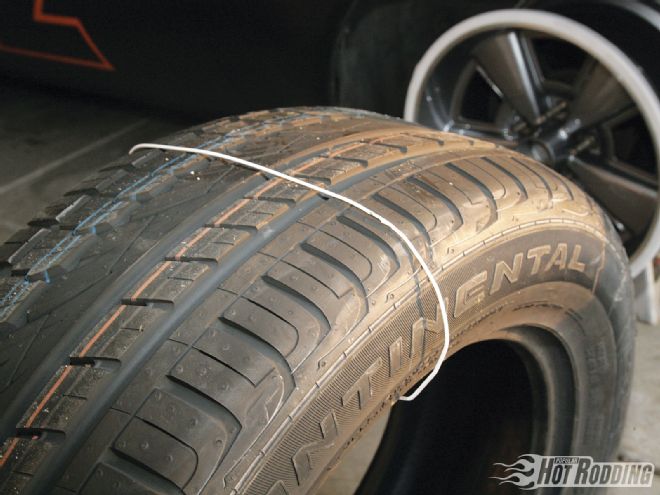
The stance of the car is sweet. To look at the profile, you'd swear the car was 'bagged, but it isn't. In fact, with the front lowered 2.5 inches, there's still more than 5 inches of ground clearance. Moreover, there is plenty of room on top of the front tire wheelhouse, and in the area of the wheel lip. These cars just have tons of space for big tires. That's the combo, folks.
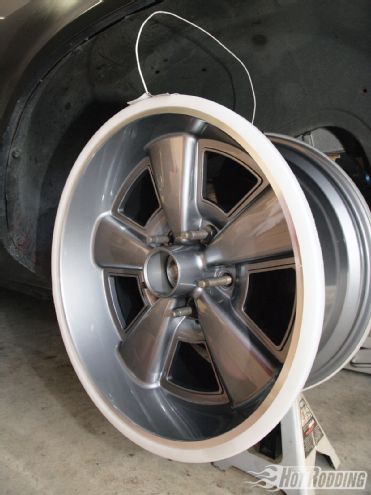 Next, we cut up an old coat hanger and wrapped it around the shape of the General Cross Contact UHP to simulate the tire cross-section. We taped the coat hanger to the inside of the rim, and then rotated the tire through the range of motion with the weight on the suspension. If your new wheel can do this, you're pretty much out of the woods.
Next, we cut up an old coat hanger and wrapped it around the shape of the General Cross Contact UHP to simulate the tire cross-section. We taped the coat hanger to the inside of the rim, and then rotated the tire through the range of motion with the weight on the suspension. If your new wheel can do this, you're pretty much out of the woods.
As for cost, this particular setup will run you about $800 for the Year One Wheels, and about $520 for the General Cross Contact UHP tires (pricing them through Tire Rack). Figure just over $1,400 total after tax and balancing.